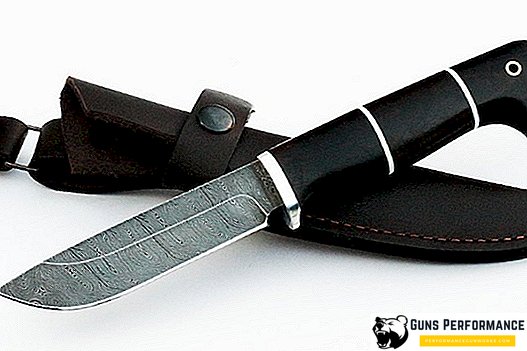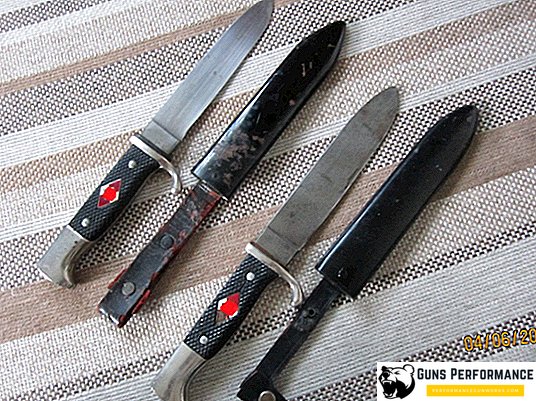
At the word "Damascus knives", ancient blades with a thousand-year history are immediately introduced, the secret of which is irretrievably lost. Few know that the secret of making knives from Damascus has long been known, and many modern blacksmiths have put the production of Damascus hunting knives on stream. The main secret and confusion about the Damascus blades is that in fact the blades were only made in Damascus, the workpieces themselves were brought from India, where they knew the secret of making Damascus and damask.
The origin of Damascus steel

There are many versions of the appearance of Damascus steel. Many people confuse Damascus and damask, although the production of these types of steel is very different. The main versions of the appearance of Damascus blades are:
Damascus appeared as a fake damask. Real blades of damask steel were very expensive and Indian blacksmiths put ordinary iron on them with patterned plates of strong steel in order to give them the appearance of damask. Naturally, such blades were sold for export, so as not to reveal the secret.
Damascus, some called and the early European welded swords, which had a core of steel, lined with soft iron.
Japanese swords, which are repeatedly perekovyvayutsya, many mistakenly called Damascus, but the main secret of Damascus steel - a combination of soft and hard metal, folded in packages alternately and perekovovannogo many times.
Europeans first encountered Damascus in India. The warriors of Alexander the Great were amazed at the quality of Indian swords. They easily cut their armor and falcata. During the Crusades, the European knights were also surprised at how easily the Arabs sabers cut their armor. This weapon was bought by warriors worth its weight in gold and brought home.
Damascus steel fabrication methods
It is easy to make a welded Damascus, only a blade from such a Damascus is unlikely to cut well. The secret of making high-quality Damascus know the individual blacksmiths, who came to this by trial and error. They jealously guard their secrets, revealing only the composition of the package of metals, from which their best knives are shackled.
Damascus steel is obtained as follows:
- Gather a pack of several grades of metal;
- The bag is sprinkled with flux, warmed up in the furnace and forged;
- Unchained bar is cut and folded into the package;
- The whole operation with forging and cutting is repeated.
This procedure is repeated until the required number of layers is obtained, usually around 300. The pattern of Damascus steel depends on how the blacksmith folded the package when forging. With the same quality, the hunter will choose the blade with the most beautiful pattern.
Advantages and disadvantages of Damascus steel knives

Damascus knives have always been valued for unsurpassed cut quality. Many handmade knives from Damascus are a true work of art. The main advantages of Damascus blades are their reliability, the ability to keep sharpening and aggressive cutting for a long time. Many modern steels are superior to Damascus in cutting properties or blade strength, but none of the steels achieved such a combination of reliability and cutting properties as Damascus steel.
Naturally, Damascus blades have their drawbacks:
- The main disadvantage of all carbon steels is low corrosion resistance;
- The price of a good Damascus is high. It is possible to find inexpensive knives from Damascus steel, but they are suitable mainly only for "shelf" knives. Forged without compliance with technology Damascus steel will not be much better than Chinese fakes;
- Having bought a knife with a beautiful Damascus pattern, many simply regret using it. No need to spare the knife, it should work!
Damascus steel kitchen knives

Internet ads are full of headlines "kitchen knives of legendary Damascus steel." Usually, under the guise of Damascus, you try to slip ordinary steel, pickled under Damascus. The first thing you should pay attention to is the material of the blade. This is usually one kind of steel. This Damascus blade is forged from at least two varieties. The drawings on such pseudo-Damask knives are very clear and uniform. Using the ignorance of buyers who dream of buying a knife from the legendary steel, unscrupulous manufacturers sell their products ten times more expensive.
The maximum that can be expected when buying a serial kitchen knife from the so-called Damascus is a multi-layered blade, forged using classical Japanese technology. A good Damascus kitchen knife can be purchased from a blacksmith, who has studied well the technology of forging high-quality Damascus steel.
Damascus knives test against modern steel
Lovers of knives conducted many tests to study the quality of modern Damascus blades. At the test were presented the works of modern blacksmiths and one knife from an old Damascus (made from a broken saber). On the other hand, handmade knives made of 95x18 steel were presented; hv6; x12mf; 9x
The most unexpected result was shown by a knife from an old Damascus, which turned out to be welded (a core of steel in soft iron plates). In addition, the shank of this blade remained saber and was very short, because of which the saber most likely broke. Greedy eastern merchants, in pursuit of profit, spared the metal on the shanks, as a result of which the soldiers with the legendary “Damascus” sabers died in battle, having lost their weapons.
Sharpening of all modern samples was carried out at one angle, the blades were chosen similar in geometry and thickness. The test on the rope showed that Damascus occupies the middle position in the rating in terms of sharpness, but surpasses most of the samples in the duration of work without sharpening. Thus, it turned out that Damascus is more suitable for those hunters and tourists who do not like to bother with sharpening. In appearance, the blade Damascus certainly bypassed its competitors.
Handmade Damascus steel knives
The pattern on the damask blade attracts many masters of nozhedelov. Knives with damask blades are a work of art. Some craftsmen even make knives made of Damascus steel. For those who want to join the replicas of combat knives, even a bayonet can make a knife, Damascus steel on which looks quite original.

Sharpening knives made of Damascus steel
Sharpening Damascus knives is different from sharpening knives from mono steels. Beginners "grinders" are recommended to practice first on simple kitchen knives, then on ordinary hunting ones, and only after mastering the basics of sharpening, switch to Damascus. The blade on the stone should be led very carefully so as not to scratch its surface.
Not recommended to sharpen Damascus diamond sharpeners. They give jagged edges, which is due to the layering of Damascus. Jagged edge tends to crumble.
The best option is to use natural shale. Cheap gray alanya and green brazilians are perfect for this. Blade should be finished on the skin with GOI paste. A Damascus knife sharpened in this way will cut about 2–3 weeks perfectly and at the same time shave off the hair on the arm.

Knives from modern Damascus - this is a great working tool, unencumbered by grace and possessing unobtrusive beauty. In addition, there are no identical patterns on the Damascus blade, buying one, you will have a unique copy of the knife.












